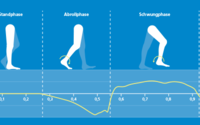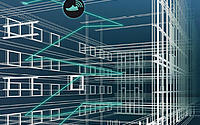- Information
- Climate, Environment & Health
MORE SAFETY AT EVERY TURN

Over 1 million firefighters risk their lives every day to save others. Operations inside buildings pose a particular risk. First, it is difficult to assess the dangers on the unknown terrain, and second, it is not yet possible to locate the exact position of the emergency forces. Common localization methods, such as satellite positioning, do not work inside - a frightening idea, especially when the rescuers themselves find themselbes in an emergency. This is why Prof. Gert Trommer and Nikolai Kronenwett of the Institute of Theories and Systems Optimisation in Electrical Engineering (ITE) have developed an autonomous system that enables self-localization without radio communication to the outside.
"Outdoors, locating people is not a problem because you can rely on satellite signals like GPS. Inside buildings, however, you cannot use this navigation because you need a direct line of sight to the satellite. The fact that no technology exists that enables reliable indoor localization surprised me and at the same time motivated me to develop my own solution," says Kronenwett. "While radiolocation without GPS would also be conceivable, it would have to access an existing infrastructure, such as a WLAN signal, which should never be a prerequisite in an emergency situation."
The developed system is based on acceleration and angular rate sensors that provide information about the direction and speed at which a person is moving - a technology that is also used in smartwatches, for example. These so-called inertial sensors are located in a few centimeters-sized device attached to the shoe. Before the emergency services enter a building, the current position is recorded once in relative or absolute terms using GPS. From this point on, no further signals are required. The person is located solely by an algorithm that calculates the absolute position based on the values provided by the inertial sensors. For this purpose, the scientists provide software that can be installed on mobile devices, such as smartphones or tablets. If this device is connected to the "foot devices" via Bluetooth, the incident commander can view the position of the rescue forces at any time via an external, independent radio link.
Attaching the device to the shoe has another advantage: "This can be used to determine when the foot is on the ground to identify when the foot's velocity is zero," explains Prof. Trommer. "This zero-velocity measurement is enormously important because it allows sensor inaccuracies to be estimated and compensated for, which in turn greatly improves the accuracy of localization. The exceptionally robust and accurate determination of these zero-velocity phases is basically what makes the technology unique." In order to be able to inform outsiders not only about the position of the rescue forces but also about the structure of the building, Kronenwett is already working on a further development. In doing so, he is supplementing the inertial sensors with an RGBD depth camera to scan the surroundings using infrared. This gives him a rough 3D image of the spaces the person has passed through.
The scientists quickly realized that there was a great demand for the developed indoor localization. It was thus all the more important for them to seek contact with industry representatives at an early stage. For now over two years, they have been working with iMAR Navigation GmbH to explore possible implementation options.
iMAR’s Managing Director, Dr.-Ing. Edgar v. Hinüber, is enthusiastic: "The idea caught our attention from the very beginning, especially since there had already been many developments worldwide in this field before that could not really meet the user expectations. We licensed KIT's technology, integrated it into our system architecture and presented it to the first customers. The response has been very positive!" Prof. Trommer adds: "For us, this is a great proof that we are on the right track. After all, that's our common goal: to detect the problems of rescue workers and increase their safety - at every turn."
"I have the utmost respect for people who risk their lives every day to help others. The prospect that our technology can one day make their everyday lives a bit safer motivates me enormously."
Images: Yurii Andreichyn / Shutterstock, bearbeitet von DER PUNKT · KIT


